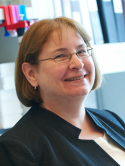An xrcc4 defect or Wortmannin stimulates homologous recombination specifically induced by double-strand breaks in mammalian cells Journal Article
| Authors: | Delacôte, F.; Han, M.; Stamato, T. D.; Jasin, M.; Lopez, B. S. |
| Article Title: | An xrcc4 defect or Wortmannin stimulates homologous recombination specifically induced by double-strand breaks in mammalian cells |
| Abstract: | Non-homologous end joining (NHEJ) and homologous recombination (HR) are two alternative/competitor pathways for the repair of DNA double-strand breaks (DSBs). To gain further insights into the regulation of DSB repair, we detail here the different HR pathways affected by (i) the inactivation of DNA-PK activity, by treatment with Wortmannin, and (ii) a mutation in the xrcc4 gene, involved in a late NHEJ step, using the XR-1 cell line. Here we have analyzed not only the impact of NHEJ inactivation on recombination induced by a single DSB targeted to the recombination substrate (using I-Scel endonuclease) but also on γ-ray- and UV-C-induced and spontaneous recombination and finally on RAd51 foci formation, i.e. on the assembly of the homologous recombination complex, at the molecular level. The results presented here show that in contrast to embryonic stem cells, the xrcc4 mutation strongly stimulates I-SceI-induced HR in adult hamster cells. More precisely, we show here that both single strand annealing and gene conversion are stimulated. In contrast, Wortmannin does not affect I-SceI-induced HR. In addition, γ-ray-induced recombination is stimulated by both xrcc4 mutation and Wortmannin treatment in an epistatic-like manner. In contrast, neither spontaneous nor UV-C-induced recombination was affected by xrcc4 mutation, showing that the channeling from NHEJ to HR is specific to DSBs. Finally, we show here that xrcc4 mutation or Wortmannin treatment results in a stimulation of Rad51 foci assembly, thus that a late NHEJ step is able to affect Rad51 recombination complex assembly. The present data suggest a model according to which NHEJ and HR do not simply compete for DSB repair but can act sequentially: a defect in a late NHEJ step is not a dead end and can make DSB available for subsequent Rad51 recombination complex assembly. |
| Keywords: | signal transduction; controlled study; unclassified drug; gene mutation; mutation; dna-binding proteins; nonhuman; animal cell; mammalia; animals; dna damage; homologous recombination; dna repair; cell line; animalia; stem cell; dna strand breakage; gene conversion; double stranded dna; regulatory mechanism; enzyme inhibitors; protein-serine-threonine kinases; recombination, genetic; models, genetic; single stranded dna; molecular biology; endonuclease; xrcc4 protein; ultraviolet rays; protein kinase; rad51 protein; wortmannin; ligase; mammal cell; rad51 recombinase; radiation tolerance; cho cells; cricetinae; gamma radiation; gamma rays; dna-activated protein kinase; genetic epistasis; androstadienes; ultraviolet c radiation; priority journal; article |
| Journal Title: | Nucleic Acids Research |
| Volume: | 30 |
| Issue: | 15 |
| ISSN: | 0305-1048 |
| Publisher: | Oxford University Press |
| Date Published: | 2002-08-01 |
| Start Page: | 3454 |
| End Page: | 3463 |
| Language: | English |
| PUBMED: | 12140331 |
| PROVIDER: | scopus |
| PMCID: | PMC137076 |
| DOI: | 10.1093/nar/gkf452 |
| DOI/URL: | |
| Notes: | Export Date: 14 November 2014 -- Source: Scopus |
Altmetric
Citation Impact
BMJ Impact Analytics
Related MSK Work





